1. 本周学习总结
1.1 以你喜欢的方式(思维导图或其他)归纳总结异常相关内容。

参考资料:XMIND
2. 书面作业
本次PTA作业题集 异常
常用异常
Q1. 题目5-1
1.1 截图你的提交结果(出现学号)
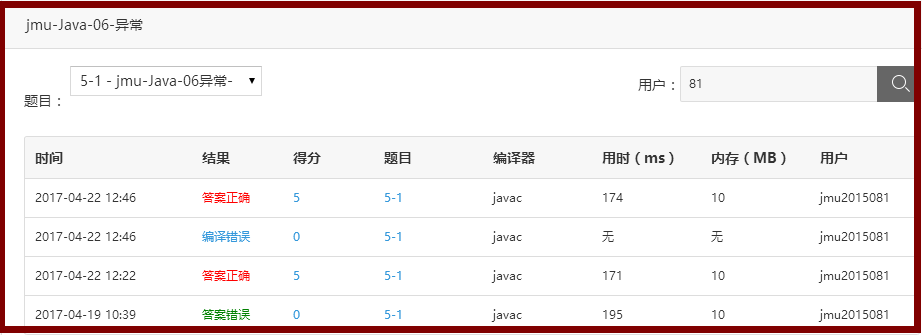
1.2 自己以前编写的代码中经常出现什么异常、需要捕获吗(为什么)?应如何避免?
- 以前经常出现ArrayIndexOutOfBoundsException(数组越界)、NullPointerException(空指针)等异常,但是这些异常都继承自RuntimeException即程序运行时发生错误。
根据上课内容,我们可以知道RuntimeException属于UncheckException即不需要被捕获的异常。 - 上面的思维导图也有提及这个问题,我们可以改进自己的代码,避免这些异常。
1.3 什么样的异常要求用户一定要使用捕获处理?
- 需要用户一定使用捕获处理的异常--CheckException。使用try-catch进行捕获,再使用throws抛出异常。
处理异常使你的程序更加健壮
Q2. 题目5-2
2.1 截图你的提交结果(出现学号)
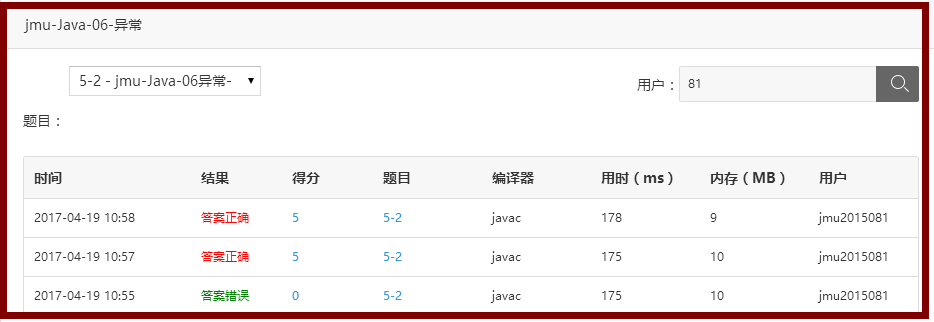
2.2 实验总结
- 这道题没什么难度,按照要求来编写就够了。
- 但是我在写的时候发现一个问题,即在数据读入的时候选取
String inputInt = sc.next();
//String inputInt = sc.nextLine();
如果选取下面的 String inputInt = sc.nextLine(); 会出现一个错误(图中绿色方框):
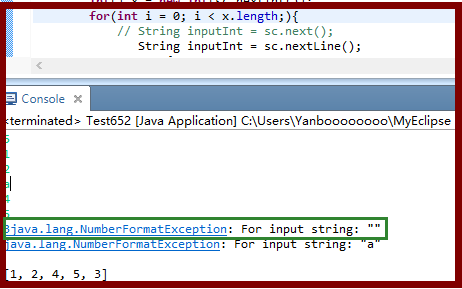
因为读入了回车。所以选择第一种方式就好了。
throw与throws
Q3. 题目5-3
3.1 截图你的提交结果(出现学号)

3.2 阅读Integer.parsetInt源代码,结合3.1说说抛出异常时需要传递给调用者一些什么信息?
先贴上源代码:
public static int parseInt(String s) throws NumberFormatException {
return parseInt(s,10);
}
public static int parseInt(String s, int radix)
throws NumberFormatException
{
/*
* WARNING: This method may be invoked early during VM initialization
* before IntegerCache is initialized. Care must be taken to not use
* the valueOf method.
*/
if (s == null) {
throw new NumberFormatException("null");
}
if (radix < Character.MIN_RADIX) {
throw new NumberFormatException("radix " + radix +
" less than Character.MIN_RADIX");
}
if (radix > Character.MAX_RADIX) {
throw new NumberFormatException("radix " + radix +
" greater than Character.MAX_RADIX");
}
int result = 0;
boolean negative = false;
int i = 0, len = s.length();
int limit = -Integer.MAX_VALUE;
int multmin;
int digit;
if (len > 0) {
char firstChar = s.charAt(0);
if (firstChar < '0') { // Possible leading "+" or "-"
if (firstChar == '-') {
negative = true;
limit = Integer.MIN_VALUE;
} else if (firstChar != '+')
throw NumberFormatException.forInputString(s);
if (len == 1) // Cannot have lone "+" or "-"
throw NumberFormatException.forInputString(s);
i++;
}
multmin = limit / radix;
while (i < len) {
// Accumulating negatively avoids surprises near MAX_VALUE
digit = Character.digit(s.charAt(i++),radix);
if (digit < 0) {
throw NumberFormatException.forInputString(s);
}
if (result < multmin) {
throw NumberFormatException.forInputString(s);
}
result *= radix;
if (result < limit + digit) {
throw NumberFormatException.forInputString(s);
}
result -= digit;
}
} else {
throw NumberFormatException.forInputString(s);
}
return negative ? result : -result;
}
-
针对不同的异常,使用throws抛出相应的异常,让用户知道出现了什么错误。例如:
①s为null,或者不在进制范围内;
②第一个字符是“+”或者“-”等等。 -
与实验5-3的功能类似。
①要求begin<end,否则抛出相应的异常java.lang.IllegalArgumentException: begin:int >= end:int;
②begin不得小于0,end不得大于arr.length,否则抛出异常java.lang.IllegalArgumentException: begin:int < 0或者java.lang.IllegalArgumentException: end:int > arr.length。
函数题
Q4. 题目4-1(多种异常的捕获)
4.1 截图你的提交结果(出现学号)
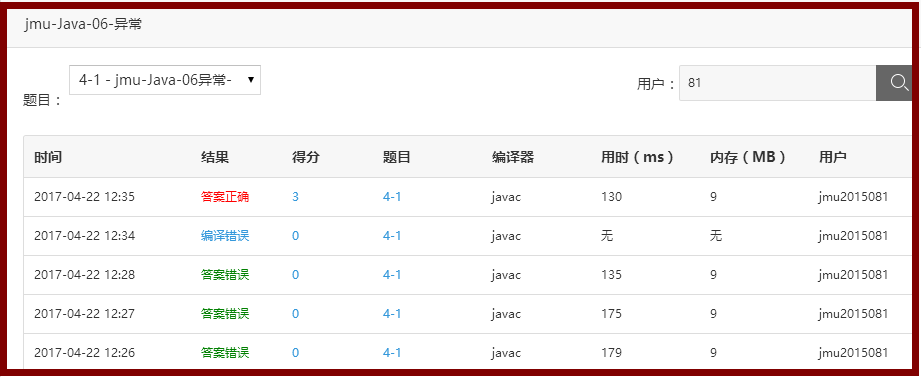
4.2 一个try块中如果可能抛出多种异常,捕获时需要注意些什么?
- 要注意父类的异常处理要放在子类的后面,否则父类的异常处理就会在子类的之前就进行了,然而我们还得不到子类的异常提示;
- 还有就是catch块,catch块中异常不得有继承关系。
Q5. 为如下代码加上异常处理
byte[] content = null;
FileInputStream fis = new FileInputStream("testfis.txt");
int bytesAvailabe = fis.available();//获得该文件可用的字节数
if(bytesAvailabe>0){
content = new byte[bytesAvailabe];//创建可容纳文件大小的数组
fis.read(content);//将文件内容读入数组
}
System.out.println(Arrays.toString(content));//打印数组内容
5.1 改正代码,让其可正常运行。注1:里面有多个方法均可能抛出异常。注2:要使用finally关闭资源。
package 博客园作业暂存;
import java.io.FileInputStream;
import java.io.IOException;
import java.util.Arrays;
public class ExceptionHandling {
public static void main(String[] args){
byte[] content = null;
FileInputStream fis = null;
try {
fis = new FileInputStream("testfis.txt");
int bytesAvailabe = fis.available();//获得该文件可用的字节数
if(bytesAvailabe>0){
content = new byte[bytesAvailabe];//创建可容纳文件大小的数组
fis.read(content);//将文件内容读入数组
}
System.out.println(Arrays.toString(content));//打印数组内容
} catch (IOException e) {
e.printStackTrace();
}finally{
if (fis != null) {
try {
fis.close();
}catch (IOException e) {
e.printStackTrace();
}
}
}
}
}
5.2 使用Java7中的try-with-resources来改写上述代码实现自动关闭资源.
package 博客园作业暂存;
import java.io.FileInputStream;
import java.io.IOException;
import java.util.Arrays;
public class ExceptionHandling02 {
public static void main(String[] args) throws IOException {
byte[] content = null;
try (FileInputStream fis = new FileInputStream("testfis.txt");){
int bytesAvailabe = fis.available();//获得该文件可用的字节数
if(bytesAvailabe>0){
content = new byte[bytesAvailabe];//创建可容纳文件大小的数组
fis.read(content);//将文件内容读入数组
}
System.out.println(Arrays.toString(content));//打印数组内容
} catch (IOException e) {
e.printStackTrace();
}
}
}
Q6. 重点考核:使用异常改进你的购物车系统(未提交,得分不超过6分)
举至少两个例子说明你是如何使用异常处理机制让你的程序变得更健壮。
说明要包含2个部分:1. 问题说明(哪里会碰到异常)。2.解决方案(关键代码)
Q7. 选做:JavaFX入门
如果未完成作业1、2的先完成1、2。贴图展示。如果已完成作业1、2的请完成作业3。内有代码,可在其上进行适当的改造。建议按照里面的教程,从头到尾自己搭建。
Q8. 选做:课外练习
JavaTutorial中Questions and Exercises
练习总结
3. 码云上代码提交记录
题目集: 异常
3.1. 码云代码提交记录
在码云的项目中,依次选择“统计-Commits历史-设置时间段”, 然后搜索并截图
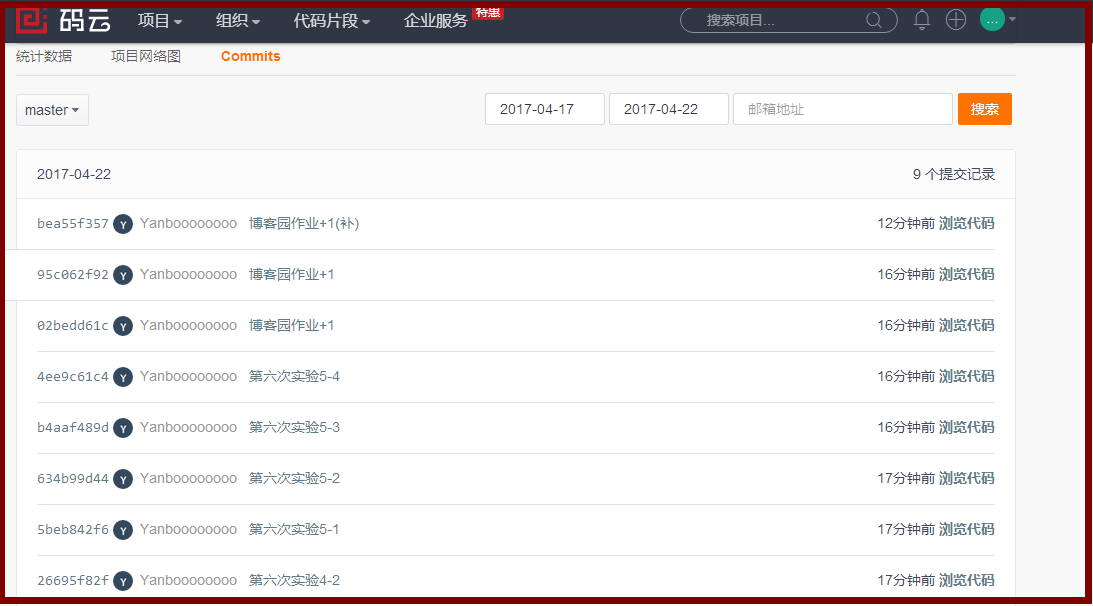
选做:4. 课外阅读
任选下面一篇文章阅读,列举出几点自己能理解的异常处理最佳实践。
Best Practices for Exception Handling
Exception-Handling Antipatterns Blog
The exceptions debate